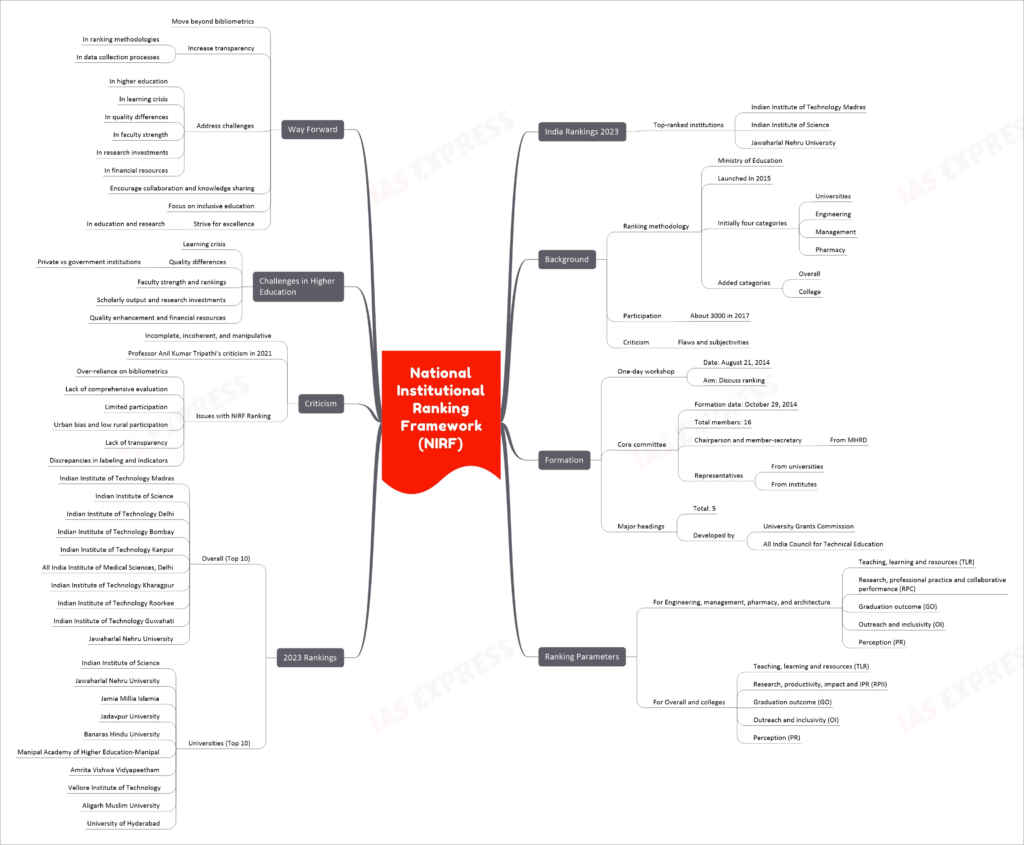National Institutional Ranking Framework (NIRF): Parameters, Criticisms, Limitations
The National Institutional Ranking Framework (NIRF) recently released the India Rankings for 2023, evaluating higher education institutions based on various parameters. The top-ranked institutions include Indian Institute of Technology Madras, Indian Institute of Science, and Jawaharlal Nehru University.
This topic of “National Institutional Ranking Framework (NIRF): Parameters, Criticisms, Limitations” is important from the perspective of the UPSC IAS Examination, which falls under General Studies Portion.
Background:
- NIRF is a ranking methodology adopted by the Ministry of Education, Government of India, to rank institutions of higher education in India.
- Approved by the Ministry of Human Resource Development (now Ministry of Education) and launched in September 2015.
- Initially had four categories: Universities, Engineering, Management, and Pharmacy. Later added two more categories: Overall and College.
- Around 3,000 institutions participated in the rankings in 2017.
- The rankings have faced criticism for their flaws and subjectivities, but the government has refused to modify the methodologies or results.
Formation:
- A one-day workshop was organized by MHRD on August 21, 2014, to discuss the ranking of institutions.
- A core committee consisting of 16 members was constituted on October 29, 2014, with the chairperson and member-secretary from MHRD, along with representatives from universities and institutes.
- The committee suggested a set of measurable parameters grouped into five major headings.
- The University Grants Commission and the All India Council for Technical Education developed frameworks for ranking universities and colleges offering management, pharmacy, and architecture education.
Ranking Parameters:
- The parameters used for ranking institutions vary depending on the category.
- Engineering, management, pharmacy, and architecture institutions are ranked based on parameters like teaching, learning and resources (TLR), research, professional practice and collaborative performance (RPC), graduation outcome (GO), outreach and inclusivity (OI), and perception (PR).
- Overall and colleges are ranked based on parameters like teaching, learning and resources (TLR), research, productivity, impact and IPR (RPII), graduation outcome (GO), outreach and inclusivity (OI), and perception (PR).
Latest Ranking – 2023:
Overall (Top 10):
- Indian Institute of Technology Madras (Chennai, Tamil Nadu)
- Indian Institute of Science (Bengaluru, Karnataka)
- Indian Institute of Technology Delhi (New Delhi, Delhi)
- Indian Institute of Technology Bombay (Mumbai, Maharashtra)
- Indian Institute of Technology Kanpur (Kanpur, Uttar Pradesh)
- All India Institute of Medical Sciences, Delhi (New Delhi, Delhi)
- Indian Institute of Technology Kharagpur (Kharagpur, West Bengal)
- Indian Institute of Technology Roorkee (Roorkee, Uttarakhand)
- Indian Institute of Technology Guwahati (Guwahati, Assam)
- Jawaharlal Nehru University (New Delhi, Delhi)
Universities (Top 10):
- Indian Institute of Science (Bengaluru, Karnataka)
- Jawaharlal Nehru University (New Delhi, Delhi)
- Jamia Millia Islamia (New Delhi, Delhi)
- Jadavpur University (Kolkata, West Bengal)
- Banaras Hindu University (Varanasi, Uttar Pradesh)
- Manipal Academy of Higher Education-Manipal (Manipal, Karnataka)
- Amrita Vishwa Vidyapeetham (Coimbatore, Tamil Nadu)
- Vellore Institute of Technology (Vellore, Tamil Nadu)
- Aligarh Muslim University (Aligarh, Uttar Pradesh)
- University of Hyderabad (Hyderabad, Telangana)
Criticism:
- The rankings have been criticized for being incomplete, incoherent, and manipulative.
- In 2021, Professor Anil Kumar Tripathi of Banaras Hindu University criticized the rankings for not considering the varying student numbers and budgets of institutions.
Issues with the NIRF Ranking:
- Over-reliance on bibliometrics: The rankings heavily rely on bibliometric measures, which may not fully capture the complexities of scientific performance.
- Lack of comprehensive evaluation: The rankings focus on certain indicators while neglecting other important factors.
- Limited participation: Only a small percentage of higher educational institutions participate in the ranking process.
- Urban bias and low progress in rural participation: The rankings are more concentrated in urban areas and lack representation from colleges in rural areas.
- Lack of transparency: The ranking methodology and data sources should be more transparent to provide detailed information to institutions and stakeholders.
- Discrepancies in labeling and indicators: The labeling of research quantity and quality indicators in the ranking framework is imprecise and potentially misleading.
Challenges in Higher Education:
- Learning crisis: There is a severe learning crisis in India, with a large percentage of students unable to read at their grade level.
- Quality differences: There are significant quality differences between private and government institutions.
- Faculty strength and rankings: There are vast differences in faculty strength between top-ranked and other institutions, highlighting the importance of quality education beyond infrastructure.
- Scholarly output and research investments: Only a small percentage of institutions contribute to a significant portion of scholarly output, indicating the need for increased research investments.
- Need for quality enhancement and financial resources: The rankings emphasize the need for improving quality in higher education, requiring substantial financial resources.
Way Forward:
- Move beyond relying solely on bibliometrics and incorporate a wider range of qualitative and quantitative factors for a more comprehensive evaluation.
- Increase transparency in ranking methodologies and data collection processes.
- Address the challenges in higher education, including the learning crisis, quality differences, faculty strength, research investments, and financial resources.
- Encourage collaboration and knowledge sharing between institutions to improve overall quality in the higher education system.
- Focus on inclusive education and ensure representation from rural areas and underprivileged communities in the rankings.
- Strive for excellence in education and research rather than prioritizing metrics and rankings.


